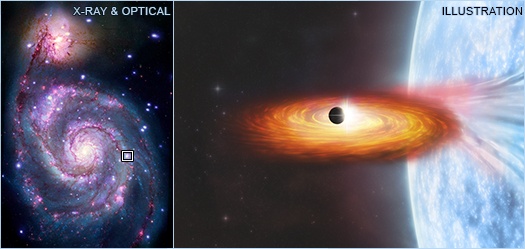Discovery of the first exoplanet candidate in X-ray binary M51-ULS-1 in the spiral Kashta e Kumtrit Messier 51 (M51), also called the Whirlpool Kashta e Kumtrit using transit technique by observing dips in brightness at X-ray wavelengths (instead of optical wavelengths) is pathbreaking and a game changer because it overcomes the limitation of observation of dips in brightness at optical wavelengths and opens up the avenue for the search of eksoplanetëve in external galaxies. Detection and characterisation of planetet in external galaxies has significant implications for search for extra-terrestrial life.
“Por ku janë të gjithë?” Fermi had blurted out, way back in the summer of 1950, pondering why there is no evidence of any extra-terrestrial life (ET) out in the hapësirë despite high probability of its existence. Three quarters of the century past that famous line, still there is no evidence of any life anywhere outside the Earth, but the search continues and one of the key components of this search is the detection of planetet outside the solar system and its characterisation for possible signatures of life.
Mbi 4300 eksoplanetëve janë zbuluar në dekadat e fundit të cilat mund të kenë ose jo kushte të përshtatshme për të mbështetur jetën. Të gjithë ata u gjetën në shtëpinë tonë Kashta e Kumtrit. jo exoplanet was known to be discovered outside the Milky Way. In fact, there is no evidence to support the idea of presence of planetary system in any external Kashta e Kumtrit.
Scientists have now reported zbulim of a possible exoplanet candidate in an external Kashta e Kumtrit for the first time. This extrasolar planet is in the spiral Kashta e Kumtrit Messier 51 (M51), also called the Whirlpool Kashta e Kumtrit, situated at a distance of about 28 million light years away from home Kashta e Kumtrit rruga e Qumështit.
Zakonisht, a planet is detected by way of observing eclipse it produces when it transits in front of its yll ndërsa orbital around thus blocking the light emanating from the yll (transit technique). This event is observed as temporary dimming of the star. Search for an exoplanet involves searching for dips in the light of a yll. The other method of detection of planetet is by radial velocity measurements. All eksoplanetëve have been detected using these techniques in our home galaxy at relatively short intra-galactic distances in the range of 3000 light years.
However, searching for dips in the light at larger inter-galactic distances to detect eksoplanetëve outside the Milky Way is an uphill task because an external galaxy occupies a small area in the sky and the high density of yjet does not allow study of an individual star in sufficient details to enable detection of signatures of a planet. As a result, search at optical wavelength in an external galaxy was not feasible until now and no exoplanet outside our home galaxy could be discovered. The latest research is pathbreaking and a game changer because it seemingly overcomes this limitation by observing dips in brightness at X-ray wavelengths (instead of optical wavelengths), and opens up the avenue for the search of eksoplanetëve in other galaxies.
X-ray binaries (XRBs) in the external galaxies are considered to be ideal for the search of eksoplanetëve. These (i.e., XRBs) are a class of binary yjet made up of a normal star and a collapsed star like white dwarf or a vrimë e zezë. Kur yjet janë mjaft afër, materiali nga ylli normal tërhiqet nga ylli normal drejt yllit të dendur për shkak të gravitetit. Si rezultat, materiali akretues pranë yllit të dendur nxehet dhe shkëlqen në rrezet X duke u shfaqur si burime të ndritshme të rrezeve X (XRS).
With an idea to detect planetet orbital X-ray binaries (XRBs), the research team searched for dips in the brightness of X-ray received from the bright X-ray binaries (XRBs) in three external galaxies, M51, M101, and M104.
Ekipi më në fund u fokusua në binarin me rreze X M51-ULS-1, i cili është një nga burimet më të ndritshme të rrezeve X në galaktikën M51. U vu re një rënie në shkëlqimin e rrezeve X të marra nga teleskopi Chandra. Të dhënat rreth rënies së shkëlqimit u ekzaminuan për mundësi të ndryshme dhe u gjetën të përshtatshme për tranzit nga një planet, me shumë gjasa të madhësisë së Saturnit.
This study is also novel for carrying out the search of eksoplanetëve successfully for the first time at X-ray wavelength. On the broadest level, this landmark zbulim of exoplanet outside our home galaxy expands the scope of search of eksoplanetëve to other external galaxies, which has implications for the search of extra-terrestrial intelligent life.
***
Burimet:
- Di Stefano, R., Berndtsson, J., Urquhart, R. et al. Një kandidat i mundshëm i planetit në një galaktikë të jashtme i zbuluar përmes transitit me rreze X. Astronomia e Natyrës (2021). DOI: https://doi.org/10.1038/s41550-021-01495-w. E disponueshme edhe online në https://chandra.harvard.edu/photo/2021/m51/m51_paper.pdf. Versioni paraprak i disponueshëm në https://arxiv.org/pdf/2009.08987.pdf
- NASA. Chandra sheh prova për planetin e mundshëm në një galaktikë tjetër. E disponueshme në internet në https://chandra.harvard.edu/photo/2021/m51/
- NASA. Shkenca – Objektet – Yjet binare me rreze X. E disponueshme në internet në https://imagine.gsfc.nasa.gov/science/objects/binary_stars2.html
- Schwieterman E., Kiang N., et al 2018. Biosignatures Exoplanet: Një përmbledhje e Shenjave të Jetës të Detektueshme nga Distanca. Astrobiologjia Vëll. 18, Nr. 6. Publikuar në internet më 1 qershor 2018. DOI: https://doi.org/10.1089/ast.2017.1729






































